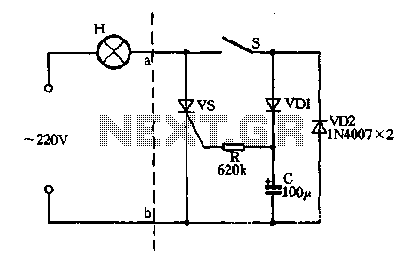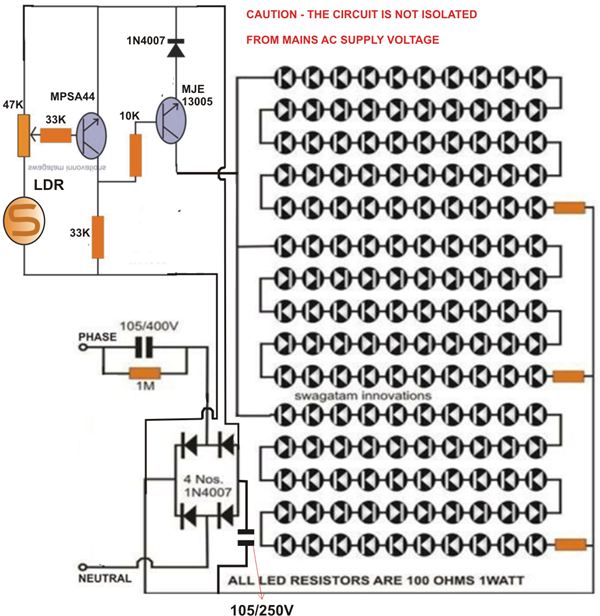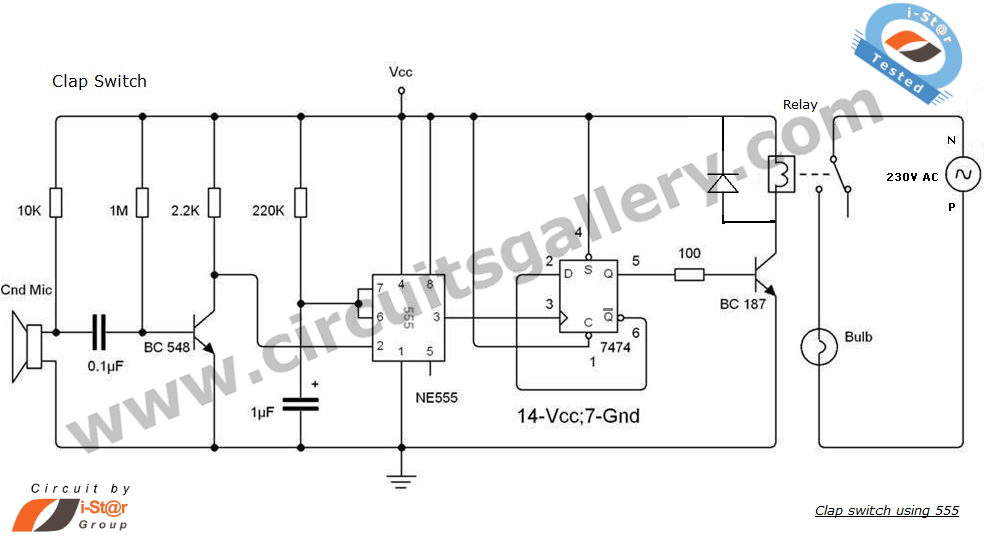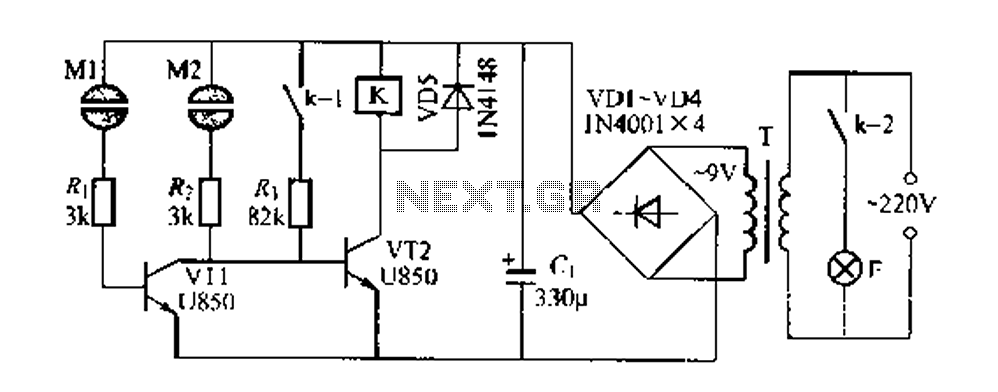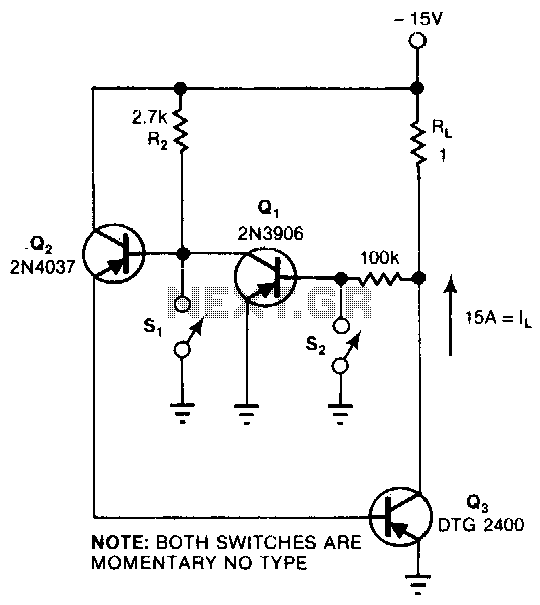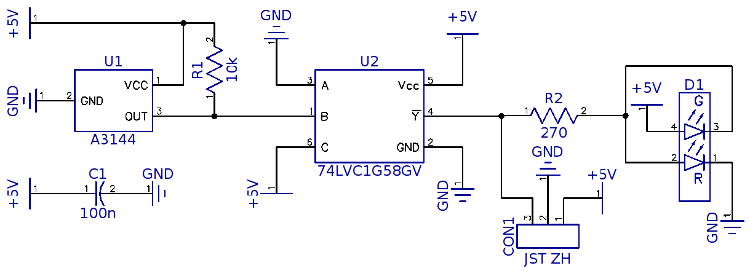
tr switch
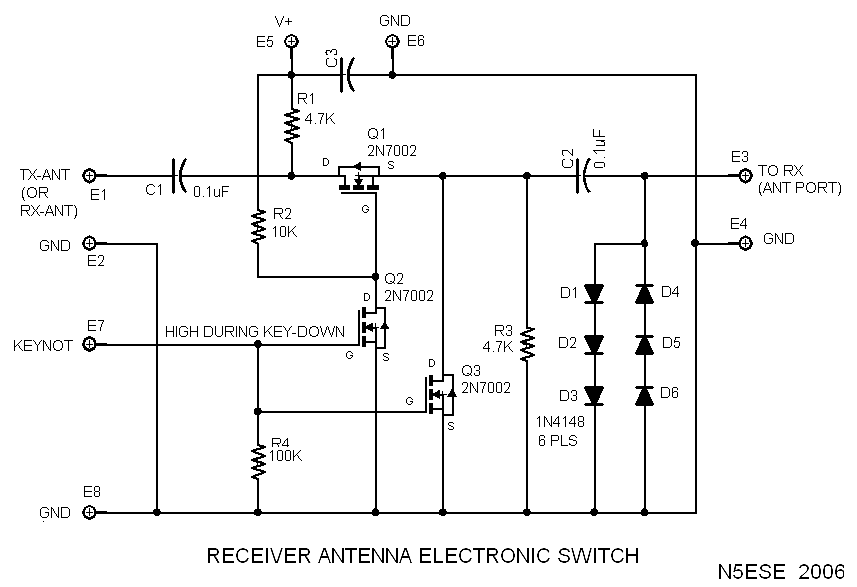
The project presented is a universal QRP T/R (transmit/receive) switch designed to connect any QRP (less than 10W) receiver and CW (continuous wave) transmitter seamlessly. The design focuses on essential functionalities, making it suitable for simple transmitters and receivers with minimal additional features. The operational scenario described illustrates how the device can be applied to various QRP transmitters and receivers. Notably, the use of three 2N7000 power MOSFETs in the final stage of the AT Sprint transceiver by Steve Weber, KD1JV, demonstrated their potential beyond audio or power-control applications. These MOSFETs can serve as an "on/off" switch for RF energy between the transmit line and the receiver's antenna input, providing protection by shunting unwanted energy. Following experimentation in SPICE, an essential T/R switch circuit was developed. The schematic indicates that the transmit signal is tapped at the transmitter output and connects to the left "TX-ANT" port. Q1 connects the receiver antenna port ("TO RX") to the antenna during receive mode and isolates it during transmit mode. Due to some leakage from Q1, Q3 shorts the receiver input during transmission. An array of diodes limits any incoming signals during receive periods to approximately 4 volts peak-to-peak. Q2 acts as a control buffer for Q1, receiving a "high" control signal from the "KEYNOT" port, which is part of the control circuitry.
The universal QRP T/R switch circuit operates by utilizing the unique characteristics of MOSFETs to manage RF signals effectively. The primary components include three 2N7000 MOSFETs (Q1, Q2, and Q3) and an array of diodes. Q1 is responsible for switching the connection between the receiver's antenna input and the antenna itself. During the receive mode, Q1 is activated, allowing the RF signals from the antenna to reach the receiver. Conversely, during transmission, Q1 is turned off, and Q3 is activated to short the receiver input, thus preventing any RF energy from damaging the receiver.
The design also incorporates a diode array that acts as a voltage limiter, ensuring that any signals that inadvertently reach the receiver during transmission do not exceed 4 volts peak-to-peak. This feature is crucial for protecting sensitive receiver components from potential damage caused by high voltage spikes. The control mechanism for the T/R switch is managed by Q2, which serves as a buffer that responds to control signals from the KEYNOT port. This control signal is typically generated by the transmitter or control circuitry, allowing for seamless integration into various QRP setups.
The overall design emphasizes simplicity and reliability, making it an ideal solution for amateur radio operators looking to enhance their QRP systems. The T/R switch circuit can be easily implemented on a PCB, with careful attention to the layout to minimize parasitic capacitance and inductance, ensuring optimal performance at the desired frequency ranges. The universal nature of this T/R switch allows it to be adapted for a wide range of applications, making it a valuable addition to any QRP enthusiast's toolkit.The project I present here is my attempt at a universal QRP T/R switch. The idea is to take care of the essentials, so that any QRP (i. e. , less than 10W) receiver *AND* CW transmitter can be connected, and work seamlessly. These are what I considered the "essentials" to be: The operational scenario would be as follows, and could easily be applied to any QRP transmitter (or transceiver used as a transmitter) and any receiver (or transceiver used as a receiver). But the device is especially designed to accommodate a simple transmitter and receiver, each having few embellishments, and requiring none.
Operationally, here`s how a typical case would work: When Steve Weber, KD1JV, used three 2N7000 power MosFETs in the final of his AT Sprint transceiver, and managed to produce 6 watts with same (4W at 20 Meters), it really opened my eyes to these little devices. I had always thought of these as audio or power-control devices, but now I began to think in a different direction.
One thing that immediately occured to me is that these devices might be configured in such a manner as to provide an "on/off" switch to RF energy between the transmit line and the receiver`s antenna input. They could additionally provide protection to the receiver, by shunting any unwanted energy that might make it as far as the receiver`s antenna input.
This led to some experimenting in SPICE, and eventually to the following essential T/R switch circuit: Let`s review the schematic. The transmit signal is tapped at the transmitter output - the transmitter remains connected to the antenna at all times - and arrives at the left "TX-ANT" port.
Q1 serves to connect the receiver antenna port (right, "TO RX") to the antenna (during receive), or isolate it (during transmit). Because Q1 does not completely isolate the transmit signal (because of device leakage), Q3 serves to short the receiver input during transmit.
The array of diodes clips any signals that may arrive during receive periods, and limits any voltage presented to the receiver antenna input to about 4 Volts peak-to-peak. Q2 is the control buffer for Q1. A "high" control signal to the "KEYNOT" port (from the control circuitry, representing the 🔗 External reference
The universal QRP T/R switch circuit operates by utilizing the unique characteristics of MOSFETs to manage RF signals effectively. The primary components include three 2N7000 MOSFETs (Q1, Q2, and Q3) and an array of diodes. Q1 is responsible for switching the connection between the receiver's antenna input and the antenna itself. During the receive mode, Q1 is activated, allowing the RF signals from the antenna to reach the receiver. Conversely, during transmission, Q1 is turned off, and Q3 is activated to short the receiver input, thus preventing any RF energy from damaging the receiver.
The design also incorporates a diode array that acts as a voltage limiter, ensuring that any signals that inadvertently reach the receiver during transmission do not exceed 4 volts peak-to-peak. This feature is crucial for protecting sensitive receiver components from potential damage caused by high voltage spikes. The control mechanism for the T/R switch is managed by Q2, which serves as a buffer that responds to control signals from the KEYNOT port. This control signal is typically generated by the transmitter or control circuitry, allowing for seamless integration into various QRP setups.
The overall design emphasizes simplicity and reliability, making it an ideal solution for amateur radio operators looking to enhance their QRP systems. The T/R switch circuit can be easily implemented on a PCB, with careful attention to the layout to minimize parasitic capacitance and inductance, ensuring optimal performance at the desired frequency ranges. The universal nature of this T/R switch allows it to be adapted for a wide range of applications, making it a valuable addition to any QRP enthusiast's toolkit.The project I present here is my attempt at a universal QRP T/R switch. The idea is to take care of the essentials, so that any QRP (i. e. , less than 10W) receiver *AND* CW transmitter can be connected, and work seamlessly. These are what I considered the "essentials" to be: The operational scenario would be as follows, and could easily be applied to any QRP transmitter (or transceiver used as a transmitter) and any receiver (or transceiver used as a receiver). But the device is especially designed to accommodate a simple transmitter and receiver, each having few embellishments, and requiring none.
Operationally, here`s how a typical case would work: When Steve Weber, KD1JV, used three 2N7000 power MosFETs in the final of his AT Sprint transceiver, and managed to produce 6 watts with same (4W at 20 Meters), it really opened my eyes to these little devices. I had always thought of these as audio or power-control devices, but now I began to think in a different direction.
One thing that immediately occured to me is that these devices might be configured in such a manner as to provide an "on/off" switch to RF energy between the transmit line and the receiver`s antenna input. They could additionally provide protection to the receiver, by shunting any unwanted energy that might make it as far as the receiver`s antenna input.
This led to some experimenting in SPICE, and eventually to the following essential T/R switch circuit: Let`s review the schematic. The transmit signal is tapped at the transmitter output - the transmitter remains connected to the antenna at all times - and arrives at the left "TX-ANT" port.
Q1 serves to connect the receiver antenna port (right, "TO RX") to the antenna (during receive), or isolate it (during transmit). Because Q1 does not completely isolate the transmit signal (because of device leakage), Q3 serves to short the receiver input during transmit.
The array of diodes clips any signals that may arrive during receive periods, and limits any voltage presented to the receiver antenna input to about 4 Volts peak-to-peak. Q2 is the control buffer for Q1. A "high" control signal to the "KEYNOT" port (from the control circuitry, representing the 🔗 External reference
Warning: include(partials/cookie-banner.php): Failed to open stream: Permission denied in /var/www/html/nextgr/view-circuit.php on line 713
Warning: include(): Failed opening 'partials/cookie-banner.php' for inclusion (include_path='.:/usr/share/php') in /var/www/html/nextgr/view-circuit.php on line 713
